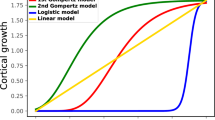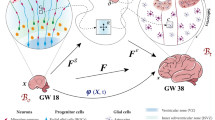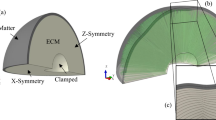Abstract
The rapid growth of the human cortex during development is accompanied by the folding of the brain into a highly convoluted structure1,2,3. Recent studies have focused on the genetic and cellular regulation of cortical growth4,5,6,7,8, but understanding the formation of the gyral and sulcal convolutions also requires consideration of the geometry and physical shaping of the growing brain9,10,11,12,13,14,15. To study this, we use magnetic resonance images to build a 3D-printed layered gel mimic of the developing smooth fetal brain; when immersed in a solvent, the outer layer swells relative to the core, mimicking cortical growth. This relative growth puts the outer layer into mechanical compression and leads to sulci and gyri similar to those in fetal brains. Starting with the same initial geometry, we also build numerical simulations of the brain modelled as a soft tissue with a growing cortex, and show that this also produces the characteristic patterns of convolutions over a realistic developmental course. All together, our results show that although many molecular determinants control the tangential expansion of the cortex, the size, shape, placement and orientation of the folds arise through iterations and variations of an elementary mechanical instability modulated by early fetal brain geometry.
This is a preview of subscription content, access via your institution
Access options
Subscribe to this journal
Receive 12 print issues and online access
$259.00 per year
only $21.58 per issue
Buy this article
- Purchase on SpringerLink
- Instant access to full article PDF
Prices may be subject to local taxes which are calculated during checkout




Similar content being viewed by others
References
Griffiths, P. D., Reeves, M., Morris, J. & Larroche, J. Atlas of Fetal and Neonatal Brain MR Imaging (Mosby, 2010).
Girard, N. & Gambarelli, D. Normal Fetal Brain: Magnetic Resonance Imaging. An Atlas with Anatomic Correlations (Label Production, 2001).
Armstrong, E., Scleicher, A., Omran, H., Curtis, M. & Zilles, K. The ontogeny of human gyrification. Cereb. Cortex 5, 56–63 (1995).
Sun, T. & Hevner, R. F. Growth and folding of the mammalian cerebral cortex: from molecules to malformations. Nature Rev. Neurosci. 15, 217–232 (2014).
Lui, J. H., Hansen, D. V. & Kriegstein, A. R. Development and evolution of the human neocortex. Cell 146, 18–36 (2011).
Bae, B. et al. Evolutionarily dynamic alternative splicing of GPR56 regulates regional cerebral cortical patterning. Science 343, 764–768 (2014).
Rash, B. G., Tomasi, S., Lim, H. D., Suh, C. Y. & Vaccarino, F. M. Cortical gyrification induced by fibroblast growth factor 2 in the mouse brain. J. Neurosci. 33, 10802–10814 (2013).
Reillo, I., de Juan Romero, C., Garcia-Cabezas, M. A. & Borrell, V. A role of intermediate radial glia in the tangential expansion of the mammalian cerebral cortex. Cereb. Cortex 21, 1674–1694 (2011).
Richman, D. P., Stewart, R. M., Hutchinson, J. W. & Caviness, V. S. Jr Mechanical model of brain convolutional development. Science 189, 18–21 (1975).
Xu, G. et al. Axons pull on the brain, but tension does not drive cortical folding. J. Biomech. Eng. 132, 071013 (2010).
Toro, R. & Burnod, Y. A morphogenetic model for the development of cortical convolutions. Cereb. Cortex 15, 1900–1913 (2005).
Nie, J. et al. A computational model of cerebral cortex folding. J. Theor. Biol. 264, 467–478 (2010).
Budday, S., Raybaud, C. & Kuhl, E. A mechanical model predicts morphological abnormalities in the developing human brain. Sci. Rep. 4, 5644 (2014).
Bayly, P. V., Okamoto, R. J., Xu, G., Shi, Y. & Taber, L. A. A cortical folding model incorporating stress-dependent growth explains gyral wavelengths and stress patterns in the developing brain. Phys. Biol. 10, 016005 (2013).
Tallinen, T., Chung, J. Y., Biggins, J. S. & Mahadevan, L. Gyrification from constrained cortical expansion. Proc. Natl Acad. Sci. USA 111, 12667–12672 (2014).
Ono, M., Kubik, S. & Abernathey, C. D. Atlas of the Cerebral Sulci (Georg Thieme Verlag, 1990).
Striedter, G. F. Principles of Brain Evolution (Sinauer Associates, 2005).
Mota, B. & Herculano-Houzel, S. Cortical folding scales universally with surface area and thickness, not number of neurons. Science 349, 74–77 (2015).
Zilles, K., Palomero-Gallagher, N. & Amunts, K. Development of cortical folding during evolution and ontogeny. Trends Neurosci. 36, 275–284 (2013).
Welker, W. Why does cerebral cortex fissure and fold: a review of determinants of gyri and sulci. Cereb. Cortex 8, 3–136 (1990).
van Essen, D. C. A tension based theory of morphogenesis and compact wiring in the central nervous system. Nature 385, 313–318 (1997).
Ronan, L. et al. Differential tangential expansion as a mechanism for cortical gyrification. Cereb. Cortex 24, 2219–2228 (2014).
Holland, M. A., Miller, K. E. & Kuhl, E. Emerging brain morphologies from axonal elongation. Ann. Biomed. Eng. 43, 1640–1653 (2015).
Striedter, G. F., Srinivasan, S. & Monuki, E. S. Cortical folding: when, where, how and why? Annu. Rev. Neurosci. 38, 291–307 (2015).
Bayly, P. V., Taber, L. A. & Kroenke, C. D. Mechanical forces in cerebral cortical folding: a review of measurements and models. J. Mech. Behav. Biomed. 29, 568–581 (2013).
Todd, P. H. A geometric model for the cortical folding pattern of simple folded brains. J. Theor. Biol. 97, 529–538 (1982).
Meng, Y., Li, G., Lin, W., Gilmore, J. H. & Shen, D. Spatial distribution and longitudinal development of deep cortical sulcal landmarks in infants. NeuroImage 100, 206–218 (2014).
Li, K. et al. Gyral folding pattern analysis via surface profiling. NeuroImage 52, 1202–1214 (2010).
Biot, M. A. Mechanics of Incremental Deformations (John Wiley, 1965).
Hohlfeld, E. & Mahadevan, L. Unfolding the sulcus. Phys. Rev. Lett. 106, 105702 (2011).
Hohlfeld, E. & Mahadevan, L. Scale and nature of sulcification patterns. Phys. Rev. Lett. 109, 025701 (2012).
Tallinen, T., Biggins, J. & Mahadevan, L. Surface sulci in squeezed soft solids. Phys. Rev. Lett. 110, 024302 (2013).
Toro, R. et al. Brain size and folding of the human cerebral cortex. Cereb. Cortex 18, 2352–2357 (2008).
Germanaud, D. et al. Larger is twistier: spectral analysis of gyrification (SPANGY) applied to adult brain size polymorphism. NeuroImage 63, 1257–1272 (2012).
Lefèvre, J. et al. Are developmental trajectories of cortical folding comparable between cross-sectional datasets of fetuses and preterm newborns? Cereb. Cortex http://dx.doi.org/10.1093/cercor/bhv123 (2015).
Aronica, E., Becker, A. J. & Spreafico, R. Malformations of cortical development. Brain Pathol. 22, 380–401 (2012).
Bond, J. et al. A centrosomal mechanism involving CDK5RAP2 and CENPJ controls brain size. Nature Genet. 37, 353–355 (2005).
Hong, S. E. et al. Autosomal recessive lissencephaly with cerebellar hypoplasia is associated with human RELN mutations. Nature Genet. 26, 93–96 (2000).
Serag, A. et al. Construction of a consistent high-definition spatio-temporal atlas of the developing brain using adaptive kernel regression. NeuroImage 59, 2255–2265 (2012).
Zilles, K., Armstrong, E., Scleicher, A. & Kretschmann, H. The human pattern in gyrification in the cerebral cortex. Anat. Embryol. 170, 173–179 (1988).
Acknowledgements
We thank CSC—IT Center for Science, Finland, for computational resources and J. C. Weaver for help with 3D printing. This work was supported by the Academy of Finland (T.T.), Agence Nationale de la Recherche (ANR-12-JS03-001-01, “Modegy”) (N.G. and J.L.), the Wyss Institute for Biologically Inspired Engineering (J.Y.C. and L.M.), and fellowships from the MacArthur Foundation and the Radcliffe Institute (L.M.).
Author information
Authors and Affiliations
Contributions
T.T., J.Y.C. and L.M. conceived the model and wrote the paper. T.T. developed and performed the numerical simulations. J.Y.C. developed and performed the physical experiments. J.L. developed and performed the morphometric analyses. F.R., N.G. and J.L. provided MRI images and provided feedback on the manuscript. T.T. and L.M. coordinated the project.
Corresponding authors
Ethics declarations
Competing interests
The authors declare no competing financial interests.
Supplementary information
Supplementary Movie 1
Supplementary Movie (MOV 1114 kb)
Supplementary Movie 2
Supplementary Movie (MOV 1064 kb)
Rights and permissions
About this article
Cite this article
Tallinen, T., Chung, J., Rousseau, F. et al. On the growth and form of cortical convolutions. Nature Phys 12, 588–593 (2016). https://doi.org/10.1038/nphys3632
Received:
Accepted:
Published:
Issue date:
DOI: https://doi.org/10.1038/nphys3632
This article is cited by
-
Computational morphology and morphogenesis for empowering soft-matter engineering
Nature Computational Science (2024)
-
Complex-tensor theory of simple smectics
Nature Communications (2023)
-
Mechanical hierarchy in the formation and modulation of cortical folding patterns
Scientific Reports (2023)
-
Growth anisotropy of the extracellular matrix shapes a developing organ
Nature Communications (2023)
-
Homeotic compartment curvature and tension control spatiotemporal folding dynamics
Nature Communications (2023)



